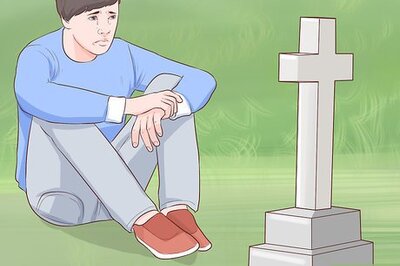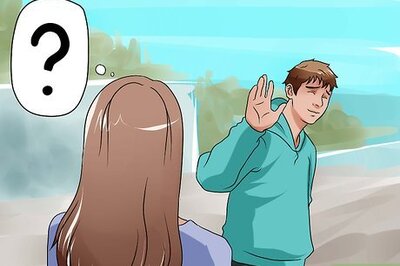
views
What is the stone tape theory?
The stone tape theory is the belief that places hold recordings of the past. In its most literal sense, a stone or other object acts like a tape recorder to make a record of an event that it can then play back on an endless loop. The stone tape theory is most associated with "residual hauntings," or the types of hauntings that are characterized by ghosts who do the same thing over and over again and seem oblivious to anything around them. The stone tape theory is not a theory in the scientific sense, like evolutionary theory. It's a paranormal concept, which is based more on individual observation and speculation rather than the rigorous testing of a hypothesis. The theory got its name from a play that aired on the BBC in 1972 called The Stone Tape Theory. The play revolved around hauntings that were replayed from literal tape recorders hidden in large stones. While the stone tape theory has influenced a lot of beliefs about ghosts that are common in popular culture, it faces criticism among 21st-century paranormal experts.
History & Evolution of the Stone Tape Theory
Spiritualism Arguably, stone tape theory wouldn't exist at all without the rise of spiritualism. Spiritualism became popular in North America and Europe in the late 19th and early 20th centuries. Before that, people generally believed that anything supernatural was the work of the devil—not that it could possibly be someone long departed who wants to communicate something. Spiritualists believed that ghosts were the spirits of those once living and that living people (specifically, trained mediums) could communicate with them. The spiritualist movement was particularly popular among women because it was one of the only spaces where women were free to speak publicly. For this reason, spiritualism is also deeply connected to the women's rights movements of that time period. Some famous mediums were later proven to be frauds, but that didn't diminish the power of spiritualism. The mediums themselves didn't need to be true for the ideas to be. Modern spiritualists are open-minded to the paranormal but don't necessarily make ghosts or the paranormal the center of their beliefs. They're much more interested in how the paranormal can be used to improve people's lives. Spiritualism is responsible for a lot of the ideas that people take for granted regarding what ghosts are and how they behave. Spiritualism speaks to "who" ghosts are.
Place memory Parapsychologists evaluate the intersection between the paranormal and human psychology. From this field, the idea emerges that intense emotions and traumatic events imprint themselves on their surroundings. This emotional residue can cause people who are sensitive to feel "off" when they're in that place. Parapsychologists who advanced the theory of place memory also speculated that there might be people who were sensitive enough (or who were specifically trained) to play those memories back like a recording and find out exactly what happened in that place to cause the residual haunting. With place memory, what's left is more of a general impression rather than an exact recording, as with stone tape theory. Place memory still influenced the development of stone tape theory in that it helped pave the way for spirits to be attached to specific places, rather than wandering around or attaching themselves to people. Place memory speaks to "where" ghosts are.
Psychometry Psychometry is the ability to read something about a person from the residue they've left on an object. During traumatic experiences or when people are feeling more emotion, they leave more residue behind, making their impression even stronger. People also leave a strong impression on items that they touch frequently, such as a comb or pen. For example, someone using psychometry might be able to learn something about a missing girl by touching or holding the girl's hair ribbon that could lead to the girl's rescue. Interestingly, the man credited with coining the term "psychometry" didn't believe it had anything to do with ghosts at all. Although he was a dedicated spiritualist, he believed psychometry was simply a mental faculty that had yet to be explored to its full potential. At the same time, the popularity of psychometry meant people generally accepted that ghosts or spirits could reside in a specific object. Psychometry speaks to "what" ghosts can attach to.
Psychic ether Psychometry's idea that objects could hold or replay memories or events from the past went dormant for a few decades after it was first proposed. Then, a paranormal researcher in the 1940s proposed that there was a space called the "psychic ether" that fell between the physical and spiritual realms. It was this ether that allowed past emotions and experiences to imprint on objects in physical space. If a haunting went away over time, it was only because the psychic ether that was imprinted on that object wore away with repeated exposure. This idea directly inspired the stone tape theory. In a way, you might say that the psychic ether is the ink used to make the recordings at the heart of the stone tape theory. Psychic ether speaks to "how" ghosts attach to physical objects.
Stone tape theory An archaeologist-turned-paranormal researcher named T.C. Lethbridge liked the psychic ether idea and wanted to build on it. In his book, he proposed that the psychic ether might be particularly prone to imprinting around certain natural features, such as mountains, rock formations, or forests. These places would be more likely to have stories of residual hauntings. Lethbridge's book is widely believed to have influenced the creators of the 1972 BBC teleplay "The Stone Tape Theory," which is where the specific name came from. In a way, this theory brings all the spiritualist theories that came before it to their logical conclusions. It provides a way in which specific events could be recorded by a specific object in a specific place, then played back over and over in the future. While the stone tape theory still left a lot of questions unanswered, it definitely provided a comfortable explanation for the types of hauntings that seem to be repeating the same actions over and over on a loop without acknowledging the outside world.
Is there evidence to support stone tape theory?
No, there's not any substantive evidence to support the theory. While there have definitely been eyewitness accounts of residual hauntings that seem to support the stone tape theory, the reality is that no one has been able to show how such things could be recorded or how they'd be played back again. Even taken metaphorically, a recording would be identical every single time it's played back, and that's not the case for eyewitness accounts of residual hauntings. If anything, the evidence that does exist seems to contradict, rather than support, the stone tape theory. Despite this lack of evidence, the theory still has proponents who argue that the recording apparatus (and the records themselves) exist on another plane. If that's the case, the truth of the theory doesn't depend on any physical evidence that humans could gather.
Criticism of the Stone Tape Theory
The stone tape theory isn't actually a theory. This criticism hinges on the use of the word "theory," which means something very specific in scientific circles. The stone tape theory isn't a scientific theory, but it's often presented in such a way that people might mistakenly believe it is a scientific theory. A lot of this criticism has to do with the fact that paranormal investigators frequently want their work to be seen as scientific, so they try to present it as scientifically as possible. Despite the scientific trappings, paranormal theories, such as the stone tape theory, are usually just something that someone came up with in their head, based on what they know and what they've seen. They haven't undergone any rigorous scientific testing.
Stone tape theory comes from fraud. Psychometry has frequently been criticized as nothing but cold reading—a group of techniques mentalists use to trick people into believing that they're psychic. The same techniques can also be used to make a haunting fit the stone tape theory, this criticism goes, which makes the stone tape theory at least a little fraudulent as well. The problem with this criticism is that just because some of these hauntings have been faked doesn't mean that all of them have been. You could have a thousand fakes and it still wouldn't mean real ones couldn't exist.
Stone tape theory doesn't have to cover all types of hauntings. Many proponents of the stone tape theory seem to believe that any theory about ghosts should cover all types of ghosts or it's a bad theory. This criticism points out that paranormal experts already accept that there are multiple types of ghosts, so it makes sense that there would be multiple valid theories to explain them. Essentially, there's no need to have one ultimate theory that explains every possible haunting. It's totally fine to have a good explanation that only covers specific types of ghosts, or specific locations.
How to Investigate 21st Century Paranormal Activity
Go back to primary sources as much as possible. The first people who witnessed the haunting are always the ones you want to talk to, if possible. If nothing else, you can guarantee that their impressions weren't influenced by other eyewitnesses' accounts that they'd already heard about. If you're researching a historical haunting, look for any reports of the first eyewitness accounts and work from there. You might also look for modern witnesses who had never heard any stories about other accounts before having their experience, although those may be few and far between. Pay attention to where eyewitnesses were standing, the time of day it was, and other environmental factors so you can recreate the setting as accurately as possible.
Focus on debunking over proving a haunting. Paranormal investigators recognize that it's pretty much impossible to provide definitive proof that a place is haunted—so they typically don't talk about proving the place is haunted at all. Rather, they're trying to eliminate any other possible reason for the phenomena observed. This focus relies on the idea that natural explanations we already understand are far more likely than supernatural explanations.
Use the scientific method to eliminate environmental explanations. Modern paranormal researchers put a lot of effort into making their investigations as scientific as possible. They're aware of the skepticism that paranormal research has attracted in the past and go out of their way to make sure any conclusions they make are supported by hard evidence. Local ghost hunting and paranormal investigation groups exist all over the world. A little bit of hunting online will likely bring up at least one group near you. Some local groups also do free events for the public where you can learn more about their methods and what they do.
Form conclusions in terms of probabilities rather than absolutes. If you're able to show that the haunting had an environmental cause, then eliminating that cause should eliminate any further haunting reports. Otherwise, it's unlikely that you've found anything in your investigation that can prove definitively whether the place is haunted or not. It's even less likely that you'll be able to prove definitively the identity of the spirit or spirits haunting the place. While you might conclude that it's highly likely to be a specific figure based on various circumstantial evidence, you'll never know for sure—and your conclusions should reflect that. For example, you might say, "Historical accounts of the room make it likely that any spiritual presence would be the plantation owner's eldest daughter, who lived there her entire life."


















Comments
0 comment